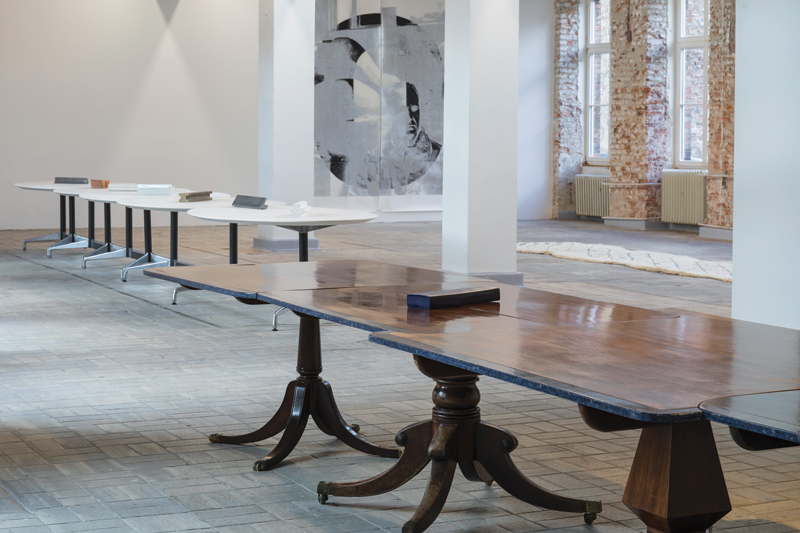« Reviews
Lucy Skaer: Available Fonts
KW Institute for Contemporary Art - Berlin, Germany
Curated by Anna Gritz
By Lydia Magyar
Confounding re-contextualizations and hybridizations are now expected from artist Lucy Skaer. In 2000, as a transient public intervention, Skaer left a scorpion and a diamond together on an Amsterdam sidewalk. In 2003, Skaer hid moth pupae and butterfly pupae in the ‘Old Bailey’, the Central Criminal Court of England and Wales. They could have hatched mid-trial, or at any other time. Her scenes work as ideas alone, and her poetic displacements continue in “Available Fonts,” curated by Anna Gritz. With this assembly of conceptual set-ups, Skaer becomes a material semiotician. The meaning of ‘fonts’ as sets of communicative parts is opened to include sculptural constructions.
In La Chasse (2017), Skaer restages scenes from the illuminated hunting manuscript Livre de la Chasse, produced between 1331 and 1391. Now in the distant future, the imagery is represented in a composition of clay, wood, metals, slate, film, rosin and lab-grown crystals. Many are components of Skaer’s previous works. The result appears to be a garden of natural and synthetic materials meant to represent trees and animals-an industrial forest dream. Skaer describes certain elements as ‘terracotta lozenges’ and ‘quartz bricks’, set down in a grid to become a place as mysterious as a chess board. One wooden sculpture is speared by wood. Seemingly, any unmoving material could be used to represent game. In this unspontaneous forest, it is striking that every object in every room was purposely placed. Brittle, disintegrating rosin is laid directly into glass windows. They appear to be permanently sealed, an invitation to re-imagine openings completely enclosed, or crumbling glass. La Chasse prods the distorted nature of abstraction and Skaer is unhindered.
Downstairs, Skaer displays One Remove (2016), a series of copied, interconnected tables and a rug that spans floor space in a multiplication of itself. One table copied is a replication of Skaer’s actual kitchen table. Skaer gives a thrilling hallucinatory quality to still objects expanded in a closed room. Film work accompanies. In Rachel, Peter, Caitlin, John (2010), the film is physically cut with geometric forms based on the ticket punches of Long Island Railroad conductors. The geometric forms visible in the film are rendered tangible objects atop the tables of One Remove. Skaer pulls objects from images like shadows making things. The beauty is in the gesture.

Lucy Skaer. Left, forefront, right: One Remove, 2016, with nine objects belonging to Rachel, Peter, Caitlin, John, 2010; Background: Untitled, 2010. Installation view at KW Institute for Contemporary Art. Photo: Frank Sperling.
One large contact print, Thames and Hudson (2009), is made from all the printable surfaces of a chair in succession. The representation of this object becomes its physical stamp, as if painting were about tools used to apply paint. The experience of “Available Fonts” is designed for breakdown. Skaer recasts systems of symbols in an expansion of the installation format. The result feels like a fictitious lesson or a new form of environmental poetry. But for the viewer, it’s unforced. Space becomes freedom here, and understanding “Available Fonts” could be walking through it.
(October 13, 2017 - January 7, 2018)
Lydia Magyar is an artist and writer based in Berlin, Germany. She is currently researching the venues of performance art in her PhD research at the European Graduate School (Division of Philosophy, Art and Critical Thought).
Filed Under: Reviews



































Leave a Reply
You must be logged in to post a comment.